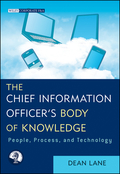
Chief information officer's body of knowledge: people, process, and technology
Lane, Dean
Down to earth, real answers on how to manage technology-from renowned IT leaders Filled with over thirty contributions from practitioners who handle both the day-to-day and longer term challenges that Information Technology (IT) departments and their parent businesses face, this hands-on, practical IT desk reference is written in lay terms for business people and IT personnel alike. Without jargon and lofty theories, this resource will help you assist your organization in addressing project risks in a global and interconnected world. Provides guidance on how business people and IT can work together to maximize business value Insights from more than thirty leading IT experts Commonsense, rational solutions for issues such as managing outsourcing relationships and operating IT as a business Offering solutions for many of the problems CIOs face, this unique book addresses the Chief Information Officer's role in managing and running IT as a business, so the IT department may become a full strategic partner in the organization's crucial decisions. ÍNDICE: Preface. Acknowledgments. Part One: People. Chapter 1: Collaboration and Teamwork (Robert Slepin). Signs, Symptoms, and Root Causes. Modeling the Way. The IT Leadership Team is Critical to Success. Developing Teaming Skills throughout IT. Recruiting for People Skills. Setting Clear Direction. Communicating Effectively. Summary. Chapter 2: Recruiting Best Practices (Walter Bacon). Internal Recruiters. Networking. Partners. Selecting a Partner. Working with Your Partner Effectively. Plan for Flexibility. Envision Your Ideal Team. Interpreting Résumés. Interviewing. Selling You, Your Team, and the Company. Checking Credentials. Summary. Chapter 3: Career Pathing. Retaining and Developing Your Best and Brightest (Art Klein). Introduction: The Challenge of IT Staffing. The Role of the CIO. The Career Pathing Solution Space: Depth, Breath, Clarity, and Flexibility. Finding Your Place in the Solution Space. Conclusion. Chapter 4: Why Provide Professional Development to IT Professionals? (John Moran, PhD). Types of Professional Development. Recommendations for the CIO andOther Executives. Conclusion. Notes. Chapter 5: Skill Building for the IT Professional. Training, Training Plans, Maintaining Skills (Rossella Derickson). Developing the Training Plan. Conclusion. Notes. Chapter 6: Retain Your Talentby Creating a Fun, Engaging Culture (Baron Concors). Show Respect. Reset Expectations. Relate to your People. Remove Hierarchies. Recognize. Relax. Summary. Chapter 7: The CIO Career Guide (Mark Wayman). You're Fired! Help Wanted. Representation from an Executive Placement Firm. The Resume It's Just a Bookmark. The Interview No Second Chance for First Impressions. Closing the Deal NeverFight over Nickels. Career Tips for CIOs. Conclusion. Part Two: Process. Chapter 8: Strategic Alignment (Tim Campos). Framework. Building the StrategicallyAligned Organization. Conclusion. Chapter 9: Developing an IT Strategy (Mark Egan). Overview. IT Strategy Methodology. Summary. Chapter 10: Competitive Applications of Technology (Michael Skaff). An Early Pioneer. Differentiation in Education. Music Making. Summary. Chapter 11: A New Paradigm for Managing a Suite of Business Processes Inexpensively (Charles Follett and Jeff Goldberg). What We Should be Doing. Case Management. Conclusion. Chapter 12: Information Technology Portfolio Management (Pamela Vaughan). What is Information Technology Portfolio Management? Understanding What ITPM is Not. ITPM Process. ITPM Best Practices. ITPM Benefits. Conclusion. Chapter 13: A Beginner's Guide to the Software Development Lifecycle (SDLC) (Stuart Robbins). Case Study: Project X.The First Meeting. The Experiment. The First Obstacle. The Second Obstacle. Conclusion. Summary. Notes. Chapter 14: Office of the CIO (Makarand Utpat). Situation. IT Strategy Creation Process. Creation of the Project Proposals by Driving an IT Strategy. Recommendations and the Current Status. Lessons Learned. Conclusion. Notes. Chapter 15: Requirements (
- ISBN: 978-1-1180-4325-7
- Editorial: John Wiley & Sons
- Encuadernacion: Cartoné
- Páginas: 360
- Fecha Publicación: 14/09/2011
- Nº Volúmenes: 1
- Idioma: Inglés
